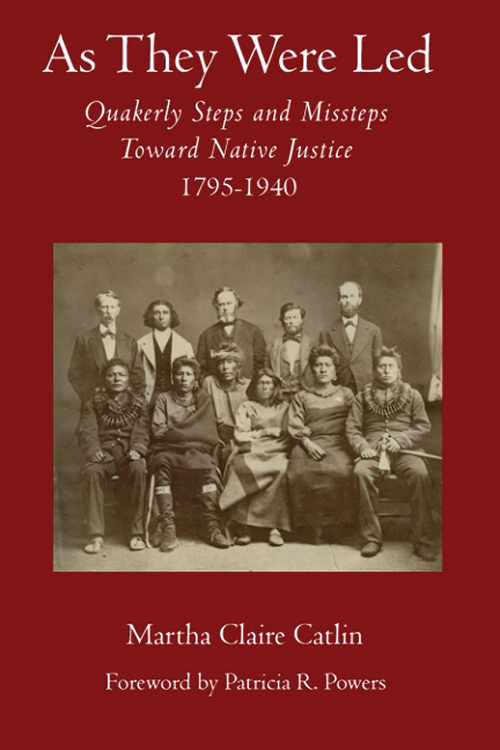
As They Were Led: Quakerly Steps and Missteps Toward Native Justice: 1795–1940
Reviewed by David Etheridge
March 1, 2022
By Martha Claire Catlin. Quaker Heron Press, 2021. 354 pages. $19.99/paperback.
In As They Were Led: Quakerly Steps and Missteps Toward Native Justice: 1795-1940, Martha Claire Catlin uses both primary and secondary sources to document the first 145-year history of the Baltimore Yearly Meeting (BYM) Indian Affairs Committee. Patricia R. Powers, who wrote the foreword for this volume, is preparing a second volume that will cover the remaining 80-plus years of the committee. This first volume is thoroughly annotated and an excellent starting point for anyone wishing to explore the history of Quaker and Native American relations.
The BYM Committee began with an action taken 18 years before its creation by Hopewell Centre (Va.) Meeting, a meeting that was then part of Philadelphia Yearly Meeting (PhYM). PhYM Friends were persuaded that Native Americans had been compensated for the lands on which they lived. However, when Friends moved into the Shenandoah Valley of Virginia, they became concerned that their new homes were on lands that had been taken from Native Americans without compensation.
Hopewell Centre Meeting responded by creating a fund in 1778 “for the benefit of the Indians, who were formerly the Native owners of the Lands on which we now live, or their descendants if to be found, and if not for the service & benefit of Other Indians.” Hopewell Friends later concluded they were not able to find those descendants. In 1779, PhYM agreed to transfer both Hopewell Centre Meeting and management of the fund (which the author estimates was worth a little over $100,000 in 2021 dollars) to BYM. Managing that fund became a core responsibility of the Indian Affairs Committee that BYM created in 1795.
The author’s accounts of nineteenth-century service on the Indian Affairs Committee reveal some characteristics of that service that are much less common on Quaker committees today. Individuals often served on that committee for decades, and children sometimes “inherited” committee membership from a parent. The standout in that regard was Philip Evan Thomas, who succeeded his son as secretary (what we now call clerk) of the committee in 1808, and who served until his death in 1861 (for a total of 53 years as committee secretary).
Committee service was more onerous than it usually is today. Most Native Nations with which the committee worked were located far from BYM territory. Conditions of both travel and communication required lengthy journeys to the Ohio Valley and western New York.
Some challenges of nineteenth-century committee service, however, are still with us today and led to some of the missteps referenced in the title. Friends spoke optimistically with Native leaders about what they might accomplish together. What Friends regarded as expressions of hope were often construed as commitments. Consequently, Friends were sometimes seen as dishonest or unreliable. Friends often offered to help Native Americans adopt European habits and values. They were frustrated when Native Americans were unenthusiastic.
During the 1840s and 1850s, the BYM committee joined in a collaborative effort with three other yearly meetings and the Haudenosaunee or Six Nations in New York and focused on the Seneca Nation. They advocated—with considerable success—to prevent the removal of the Seneca Nation from their land. BYM Friends also established schools for the Seneca.
After the Civil War, BYM Friends persuaded President Ulysses S. Grant to replace military personnel who were serving as agents responsible for managing U.S. relations with individual Indian nations with Quakers and men from other Christian denominations. The theory was that religious people would be less corrupt than military officers. Hicksite Quakers were assigned to Native Nations located in Nebraska, while Orthodox Friends were responsible for those located in Kansas and what later became Oklahoma.
In the late-nineteenth and early-twentieth century, there was an especially fascinating story of Zitkála-Šá (Lakota for Red Bird). She attended a Quaker boarding school for Native Americans and then Earlham College before becoming a teacher in the U.S. government boarding school in Carlisle, Pennsylvania. She used her knowledge as both a boarding school student and teacher to write articles in the Atlantic Monthly condemning those schools. The Indian Affairs Committee supported the work of early Native American advocacy organizations in which Zitkála-Šá was involved and arranged for her to speak at the BYM Annual Session in 1917.
David Etheridge is a member of Friends Meeting of Washington D.C. and clerk of the Baltimore Yearly Meeting Working Group on Racism. He worked for over 20 years as an attorney in the Indian Affairs Division of the Solicitor’s Office of the U.S. Department of the Interior.


